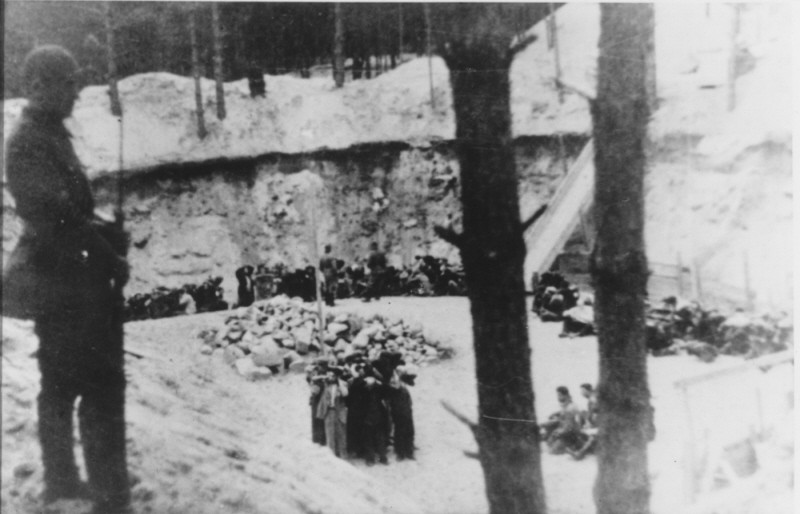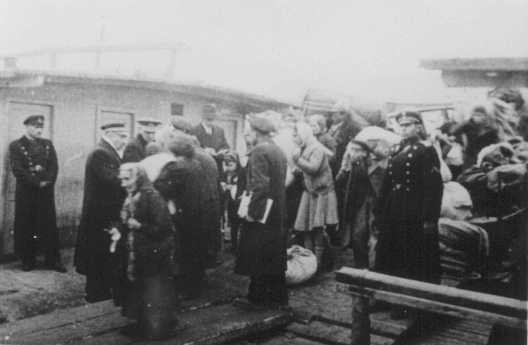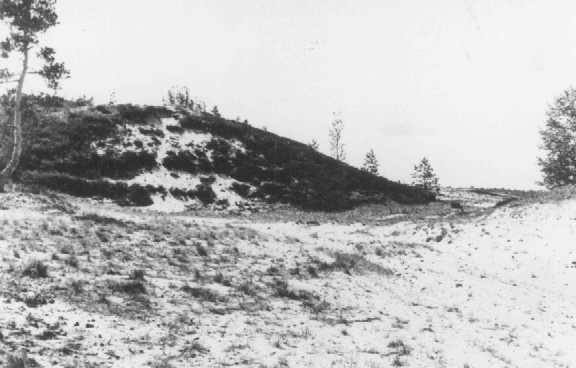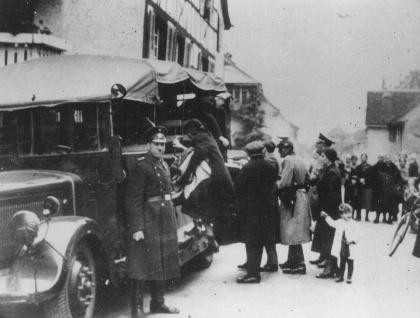
Collaboration
German authorities required the assistance of the Axis nations and of local collaborators in the regions they occupied to implement the "Final Solution." Collaborators committed some of the worst atrocities of the Holocaust era.
Key Facts
-
1
Axis governments, police, and military authorities aided in the roundup and deportation of Jews to killing centers, actively participated in the murder of Jews, and in several cases committed atrocities against their Jewish fellow citizens within their own national borders.
-
2
In territories they occupied (particularly in the east) the Germans depended on indigenous auxiliaries (civilian, military, and police) to carry out the annihilation of the Jewish population.
-
3
Axis government authorities and local auxiliaries in German-occupied regions were key in implementing expropriation, deportation for forced labor, and mass murder of non-Jewish populations.
Introduction
In Europe, antisemitism, nationalism, ethnic hatred, anti-communism, and opportunism induced citizens of nations Germany occupied to collaborate with the Nazi regime in the annihilation of the European Jews and with other Nazi racial policies. Such collaboration was a critical element in implementing the "Final Solution” and the mass murder of other groups whom the Nazi regime targeted.
Collaborators committed some of the worst atrocities of the Holocaust era.
This article looks at collaboration by Germany's allies and by occupied countries or regions.
Germany's Axis Partners
Germany's European Axis partners cooperated with the Nazi regime by promulgating and enforcing anti-Jewish legislation. In some cases, they deported their Jewish citizens and/or residents into German custody en route to killing centers or labor camps.
In some Axis states, fascist paramilitary organizations terrorized, robbed, and murdered indigenous Jews, either under German guidance or on their own initiative. The Hlinka Guard in Slovakia, the Iron Guard in Romania, the Ustasa in Croatia, and the Arrow Cross in Hungary were responsible for the deaths of thousands of Jews in their home territory. In these and other states, military personnel, police, and the gendarmerie played a key role in the expropriation, concentration, and deportation of Jewish residents in their countries.
In Hungary, Slovakia, Croatia, Bulgaria, and also in Vichy France, police, military, and gendarmerie officials were vital to implementing the German-initiated policy of deporting Jews resident in territories under their influence or control to the killing centers in the east.
Croatia
The Ustasa government of Croatia built its own concentration camps. By the end of 1942, the Croat authorities had killed more than two-thirds of Croatia's Jews (around 25,000), many of them in the Jasenovac camp system. Croat police and Ustasa militia also killed between 320,000 and 340,000 ethnic Serbs, some of them in Jasenovac, but the majority in the villages in which they resided. Slovak officials deported nearly 80% of the Slovak Jewish population in cooperation with the Germans during 1942.
Italy, Hungary, and Bulgaria

Italy and Hungary collaborated with Germany in many ways, including the promulgation of antisemitic legislation. However, neither Italy nor Hungary deported Jews until Germany directly occupied those countries.
Bulgaria cooperated willingly with the Germans in deporting Jews from territories the Bulgarians occupied as a result of the Axis dismemberment of Yugoslavia and occupation of Greece. Bulgarian authorities, responding to popular opposition and even reservations within their own government ruling party, refused to deport Jews from Bulgaria proper. They did, however, expropriate many in the Jewish community and deployed male Jews at compulsory labor during 1943 and 1944.
Romania
Romanian gendarmerie and military units directly murdered and deported Romanian and Ukrainian Jews in the re-annexed provinces of Bukovina and Bessarabia as well as in Romanian-administered Transnistria in Ukraine. Nevertheless, the Romanian government refused to deport Jews from the core provinces of Romania (Moldavia, Wallachia, southern Transylvania, and the Banat).
German-Occupied Countries and Regions
Many people in German-occupied countries and regions collaborated with the German occupation authorities.
Local Auxiliaries

Estonian, Latvian, Lithuanian, Ukrainian, and ethnic German collaborators played a significant role in killing Jews throughout eastern and southeastern Europe. Many served as perimeter guards in killing centers and were involved in the murder by poison gas of hundreds of thousands of Jews. Others, particularly ethnic Germans from southeastern Europe, served in the Nazi concentration camp system, particularly after 1942.
Lithuanians, Latvians, Estonians, Belorussians, and Ukrainians spontaneously formed groups which the German SS and police then purged and reorganized. From the beginning, members of these “partisan” or “self-defense” groups killed hundreds of Jews as well as real and perceived Communists. The German-reorganized units became ruthless and reliable police auxiliaries that assisted the German authorities—civilian, military, SS and German police—in the massacre of hundreds of thousands of Jews and millions of non-Jews in the occupied Soviet Union.
Throughout the period of the occupation, the Germans continued to recruit auxiliaries for their police forces, military units, and civilian administrations from among the native peoples of the Soviet Union.
Vichy France

The government of Vichy France cooperated with the Germans by enacting the Statut des Juifs (Jewish Law). The Statut defined Jews by race and restricted their rights. Vichy authorities also actively collaborated and even took initiative by establishing internment camps in southern France, arresting foreign Jews and French Jews, and aiding in the deportation of Jews (mostly foreign Jews residing in France) to killing centers in German-occupied Poland.
The Vichy government also turned over to the Germans Spanish and international fighters in defense of the Spanish Republic against the Franco rebels. After Franco's victory and the establishment of a conservative, authoritarian regime in 1939, these so-called Spanish Republicans or “Red Spaniards” had sought refuge in France from certain persecution and possible death if they remained in Spain. After the Vichy French turned over several thousand of the refugees to the Germans, the Germans incarcerated them in concentration camps, where thousands of them died.
Norway, Belgium, and the Netherlands
After the German invasion of Norway in April 1940, Vidkun Quisling, a Norwegian fascist, proclaimed himself prime minister. The Germans quickly became disillusioned with him and established their own administration, but intermittently used Quisling as a figurehead. Quisling's name entered the English dictionary as a term defining a person who betrayed his country through collaboration with an occupying enemy.
Norwegian police and paramilitary formations assisted SS and German police units in the deportation of Jews to Auschwitz-Birkenau. Likewise, local civilian and police authorities collaborated closely with the Germans in Belgium and the Netherlands in rounding up and deporting Jews residing in those two countries.
Critical Thinking Questions
- What pressures and motivations might lead individuals and institutions to collaborate with an oppressive or even murderous regime?
- How does propaganda and distribution of misinformation contribute to these choices?
- How can these factors be countered or limited?

